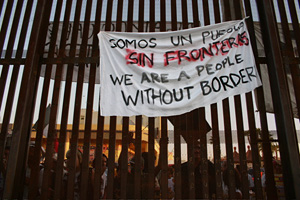 |
 |
 |
 Editorials | September 2006 Editorials | September 2006  
The US and Mexico – Walling Out Understanding
 Enrique Andrade González - MexiData.info Enrique Andrade González - MexiData.info


| | The crossing of migrants will continue, and they will continue to fill the jobs offered to low income workers who are often denied worker’s rights. |
Approval by the U.S. House of Representatives, and the expected authorization in the U.S. Senate, to build a 700 mile long fence on the southern border – strengthened by watchtowers equipped with high-tech infrared instruments and monitoring devices for motion detection sensors (to be built by The Boeing Company and a team of associates) – is the beginning of a new stage in U.S.-Mexico bilateral relations.

The first phase of the project, that includes the completion of 50 percent of the fencing over the next two years, will begin in just a few months.

All of this is part of a strategy of the United States to strengthen homeland security, and to send a positive political message to anti-immigration groups. However, over the medium to long-term this just may have a negative impact on U.S. border area economies, as well as trade relations with Mexico.

However the most immediate political implications will be seen in the November congressional elections in the United States, with Republicans hoping to use the anti-illegal immigrant atmosphere to win majorities in both houses of Congress. In turn, by holding onto majorities during the final two years of the George W. Bush term they will be in a better position to win in 2008.

And surely the poll numbers are correct, that show a majority of U.S. citizens favoring stronger security along the U.S.-Mexico border.

For Mexico, added border fencing and equipment represent a failure in its foreign policy with the United States insofar as it has been unable to influence the northern neighbor’s domestic debate. Moreover, Mexico has been unsuccessful in efforts to initiate binational talks on the causes of migration, and on programs to slow the flow of nearly 500,000 emigrants who annually cross the border illegally.

For the new Mexican government, that will take office on December 1, this is a message of distrust and further separation. It says that ‘we have little confidence you can create jobs in your country, and therefore we will stop as many people as we can from crossing the border’ – and the right of the United States to do so is without question.

In spite of some people insisting that this is part of the comprehensive reform being promoted by President Bush, there will be no immigration reforms prior to the November midterm elections.

Which also means reform allowances will not be enacted that would permit millions of Mexican migrants to remain legally in the United States, even though President Vicente Fox has celebrated this as a near fait accompli. This issue will not be taken up until next year, or it could be put on the shelf until 2009.

It is foreseeable that, in reality, nothing will change over the next two years – the first-stage for building the new fences. That is with the exception of the related jobs that will be created, and the significant spending in wartime technology by Boeing. Beyond these differences the crossing of migrants will continue, and they will continue to fill the jobs offered to low income workers who are often denied worker’s rights.

Mexico and its new government should also use this time to carry out a serious review of the North American Free Trade Agreement (NAFTA) with the United States, because it is not bringing about the benefits Mexico needs. What’s more, rather then jobs being created in Mexico they are being generated in the United States.

While labor rights are ignored, things such as minimum salaries and cross border parity in wages, and until changes come about in Mexico that will stimulate the creation of jobs, emigration will continue insofar as there are jobs north of the border for those workers who are willing to accept the conditions. And the worst of working conditions in the United States represent the best option for many people from south of the border.

The greatest wall however is not what will be built over the next few years, but a wall that already exists – the lack of understanding between the United States and Mexico regarding the migration phenomenon and its causes.

The phenomenon of migration is an effect and not a cause, and over the past five years it has gotten out of control. And if it is not attended to promptly, in two years when the first phase of the fencing and surveillance project is completed it will be a matter of national security for both the United States and Mexico.

Enrique Andrade, a Mexico City-based attorney and business consultant, writes a weekly column for MexiData.info. He can be reached via email at enriqueag@andradep.com. | 
 | |
 |



